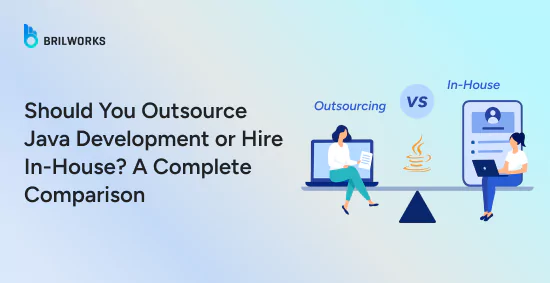COOPERATION MODEL
ARTIFICIAL INTELLIGENCE
PRODUCT ENGINEERING
DevOps & Cloud
LOW-CODE/NO-CODE DEVELOPMENT
INDUSTRY
FRONTEND DEVELOPMENT
CLOUD DEVELOPMENT
MOBILE APP DEVELOPMENT
LOW CODE/ NO CODE DEVELOPMENT
EMERGING TECHNOLOGIES








Your hunt for Java developers begins with your budget. Ultimately, it comes down to the level of skill they demonstrate, and lastly, the onboarding process. However, before all that, you face a critical decision: where do you want your development team to be? There are three options for hiring Java developers:
Freelancers
Full-Time
Outsoucing
These three options have their strengths and cons. Freelancing might prove budget-friendly, but it offers limited support, and the risk of low expertise is high. Likewise, full-time might seem reliable, but the cost might not align with the overall project ROI. Lastly, outsourcing Java development, where you can expect high reliability and expertise, has downsides that are often lower compared to the other two, due to the legal compliance and policies that the outsourcing company provides. However, one drawback that might be felt is a lack of control over the project. With each option offering you different benefits and limitations, how can you choose the correct one? We will guide you through the process of hiring Java developers who will best fit your needs.
Java is a dependable programming language that enables the creation of scalable apps and websites. Some of the world’s finest websites, such as Google & Amazon, use Java for their backends. Additionally, the popular web application Netflix utilizes Java for its entire backend process. It is highly scalable and secure, which is why Java is a favored choice for enterprise app development.
Java is likely a good choice for software development. But how can you find the right talent to create your desired application? That is why certain hiring models connect you with the right talent for a certain period. Your project type, your budget, and timeline can determine the type of hiring model you should opt for.
The main purpose of selecting the right model is to get the best possible outcome with minimal investment. For example, if your team needs a small task done for Java, let’s say that you need a bug to be fixed quickly. However, your team is busy with other tasks, so you can hire a freelancer to do that job for you. That way, your team doesn’t get overwhelmed with tasks, and you don't miss your deadline.
However, the problem arises when you have more than just bugs to fix. Perhaps you need assistance with architecture, microservices implementation, or API development. All these task demands different levels of skill and time. So if you hire a freelancer for API development, then chances are he/she will take a lot more time to complete a task than a team of developers. That is why selecting the right model becomes crucial.
Freelancing your work is a great strategy for completing your short-term goals. Freelance developers are independent contractors hired for specific tasks in software development. They are often hired for a short period. Freelance developers work on project-based engagements. They are mostly self-managed and work remotely for the most part.
Freelancing may seem risky at first, but it can be quite effective. Interestingly, in 2024, freelancers collectively generated more than USD 1 trillion in earnings, according to reports by Upwork. Moreover, according to the same report, 48% of CEOs plan to increase freelance hiring in 2025.
Freelancers are less expensive than hiring full-time developers. They usually charge on a project basis. This means you are only paying for the tasks you want to complete, nothing more.
The hiring process for freelancers is quite fast-paced. It doesn't include many contracts or long-form pages. Most freelancers can start on the same day as you decide to hire them.
Flexibility can be a perk or a hindrance of this model. However, in most cases, when used correctly, it is a significant advantage. If your project or budget requires it, you can pause or adjust the contract with freelance Java developers.
Freelancers mostly juggle between multiple clients; therefore, there is no single commitment from them towards you. Additionally, they often work remotely, so you may encounter a timeline discrepancy, which can result in unavailability from their end.
Skill levels vary widely in freelancing work. Not all freelance Java developers follow best practices or write scalable code. Vetting is on you.
Management is also a crucial factor in ensuring your project's success. As we mentioned, freelancers are mostly self-managed. They don't have any senior or project manager to manage their tasks or workload. Therefore, it is up to you to obtain updates and inquire about the project process.
If you are a founder or own a company, you may already have full-time developers. Full-time Java developers are simply the employees you hire. They often work from home, but there are also employees who work full-time remotely. They are responsible for end-to-end Java development. They are fully aware of your goal here, and they stay for the longest time. They are dedicated solely to your product, your codebase, and your goals.
According to the Stack Overflow developer survey 2024, out of all the respondents, 69% are full-time developers. Countries like the United States, Germany, India, the United Kingdom, and Ukraine have the highest percentage of full-time developers, with more than 50%.
Full time developers stay for the long haul. Over time, they come to understand your company and your customers better than freelancers. Moreover, you are aware of the skills they possess because they have undergone multiple interviews before being hired.
Most companies offer a hybrid culture, but whether your employees are in-house or working remotely, you have overall control over your project. You can communicate with them instantly through Slack channels. You also receive daily updates from them and a progress update on your work through stand-up meetings. In-house teams are easier to align across design, product, and QA.
When dealing with sensitive data, having direct oversight of your codebase and infrastructure matters. As you control the process, you can ensure that the data remains within your work.
Although hiring full-time Java developers offers greater security and control, it also comes with higher costs. By hiring full-time, you are on the hook for salary, health insurance, paid leave, workspace, equipment, etc. Moreover, keeping them for the long term comes with extra costs too.
Recruiting a skillful Java developer takes time. It can easily take 35 to 60 days just to fill one role. Because, while hiring, you don't just assess their skill, but also their overall condition. Moreover, the process involves a substantial amount of paperwork, as maintaining an office culture is also a requirement.
Once they are onboard, you can assign the tasks accordingly. But scaling down can become a problem. There are multiple rules that your company must follow to ensure a safe layoff process. That is why there are certain rules you have to follow while laying off employees. In that period, both you and your employee need time to balance the workload.
Outsourcing Java development to a company brings about the best of both models. You get a team of full-time developers, but you are hiring them for a certain amount of period. Outsourcing means you hire an external software firm that specializes in developing software and mobile applications. They already have developers who are proficient in development.
Many firms have multiple talented developers who are proficient not just in one tech stack, but in many, such as Java, React Native, ReactJS, Node.JS, and AI development, among others. This way, you don’t have to look for others, as the development company can handle both frontend and backend development on its own.
The global IT services outsourcing market was estimated at $611 billion last year. Over time, it is projected to grow to a market exceeding $1 trillion by 2034. The same report mentions that India, Eastern Europe, and Latin America are leading the global IT outsourcing as key hubs. North America remains a major client base, with increased demand for digital innovation, AI, and cybersecurity outsourcing.
Java development is a wide net of technologies. There are many tools, IDEs, and frameworks used for development. So, chances are you are also choosing your tech stack wisely. That is why for a Java development company, it's easy to arrange these developers who are particularly skilled in the technology of your choice. If you need five Java developers skilled in Spring, Hibernate, and AWS, a good outsourcing partner can staff that team in a short period of time.
Scalability is a huge advantage of outsourcing. If your app grows over time, say a million users daily, then an outsourcing team has enough capabilities to scale your app to meet the requirements. Moreover, if you want to reduce the workload you have outsourced, you can easily do so as well.
Hiring remote Java developers is less expensive than hiring full-time developers, especially if you are working with teams in Eastern Europe, Latin America, or Southeast Asia. Moreover, you won't have to pay extra perks that you pay your full-time employees, and also free up your office space.
Most outsourcing companies are dedicated to bringing daily updates. Unless you are working with a dedicated team, you become one of the several clients. This might hinder your development process and increase your development timeline. If expectations around response times and deliverables aren’t clear from day one, you will have to face this issue.
When your developers are halfway around the world, routine check-ins might mean taking calls at odd hours or waiting a day to resolve blockers. Coordinating across continents takes foresight and flexibility.
Some companies can deliver stark, enterprise-grade systems; others just ship code and move on. The difference often comes down to how well you vet potential partners. Skipping this step can leave you dealing with messy code or missed deadlines.
Every client wants to complete their task within budget. Cost is a significant factor in choosing which model to select. The budget is your overall investment that includes hiring, onboarding, management, and long-term maintenance. So, keeping these factors in mind, let's take a look at the cost of hiring Java developers.
|
Category |
Freelance |
Full-Time |
Outsourced |
|
Hourly Rate |
$10–$100+ (typical: $20–$60) |
$40–$90 (global avg); $70–$150 (North America) |
$20–$60 (Asia/LatAm); $40–$100 (Europe) |
|
Annual Cost |
~$40K–$180K (varies by workload/region) |
$80K–$160K (NA/WE); $30K–$90K (Asia/Eastern EU) |
$35K–$80K (offshore team member, avg) |
|
Typical Extras |
Minimal (no benefits/overhead) |
Benefits, insurance, payroll tax, office, etc. |
Minimal (fees rolled into contract) |
|
Best For |
Short-term, specialist, variable workloads |
Long-term, deep integration, core product teams |
Scaling quickly, full-project delivery |
The typical hourly rate for a freelance developer ranges from $20 to $60. However, if we take into consideration geography, then it can span from $10 - $100. North America and Western Europe contribute the highest rate of freelancers. Moreover, more skilled developers charge more than beginners.
Freelance developers are often hired for a short-term duration. But if you hire them for a long duration, for a year in this case, then their cost ranges from $25,000 to $130,000+.
In North America, the average is $70 to $150/hour when all costs are included. Globally, in-house rates average $40-$90 per hour, depending on experience and location.
The U.S. average is $90k to $120k per year. Senior-level developers exceed $150K in tech hubs.
Once you add benefits, taxes, onboarding, and office space, the cost can run up to $150K or more per developer in the U.S., and $60K-$130K in Western Europe. Asia and Eastern Europe see much lower costs, ranging from $30K to $90K.
In India and Southeast Asia, the typical rate is around $5 to $40. While in Eastern Europe and Latin America, the rates go up, spanning from $20 to $60. In Western Europe, it ranges from $40 to $80.
For a dedicated offshore team member, the cost is around $35K to $80K, depending on region and agency size.
Choosing between freelance, full-time, and a Java outsourcing company depends on several factors. Your project timeline, budget, complexity, team structure, and control all of these factors play a role in determining your decision. We have also created hire Java developers guide to help you navigate through this exact situation.
Freelancers work best for short-term or narrowly defined tasks like bug fixes, module development, or performance tuning. If your project has a clear start and end date, hiring a freelancer might be sufficient.
Full-time developers are ideal for ongoing product development, especially if you're building a Java-based platform that requires continuous updates and internal ownership.
Outsourced teams are well-suited for both short- and long-term engagements but shine when the project is complex, multi-layered, and demands end-to-end delivery—from architecture to deployment.
Freelancers are often the most affordable upfront, especially on an hourly or per-task basis. However, hidden costs can arise if you need to hire multiple freelancers or manage them individually.
Full-time hires involve higher long-term costs—salaries, benefits, onboarding, and infrastructure—but may be worth it for stable, growing projects.
Outsourcing can reduce overhead by giving you access to a skilled team at predictable costs. While the hourly rate might be higher than a freelancer, you save on recruitment, training, and operational expenses.
Freelancers require hands-on coordination. You’ll need to manage tasks, timelines, and communication directly.
Full-time developers offer tighter alignment with your internal processes. They’re easier to integrate into agile sprints, regular stand-ups, and company tools.
Outsourcing firms typically provide a dedicated project manager, QA team, and delivery pipeline. If you want to offload day-to-day management, outsourcing offers more structure and accountability.
Freelancers often specialize in specific skills (e.g., Spring Boot, Hibernate, or performance optimization). They’re a good fit when you need a niche expert.
Full-time hires bring long-term value but may require training or upskilling if new technologies are introduced.
Outsourced teams give you access to a broader pool of senior Java developers, architects, DevOps, and testers. This is useful when the project needs cross-functional collaboration or rapid scaling.
Freelancers can be hired quickly, but onboarding multiple individuals for a large project may slow you down.
Full-time hires often take weeks (or months) to recruit and onboard, which can delay project kickoff.
Outsourcing companies can ramp up a full team within days, especially if they already have Java developers on the bench. This makes them ideal when speed is critical.
|
Criteria |
Freelancer |
Full-Time Developer |
Outsourced Team |
|
Project Duration |
Short-term |
Long-term |
Both short- and long-term |
|
Budget |
Low upfront |
High (long-term) |
Mid to high (scalable) |
|
Oversight Required |
High |
Medium |
Low |
|
Team Scalability |
Limited |
Moderate |
High |
|
Speed to Onboard |
Fast |
Slow |
Very fast |
|
Access to Expertise |
Niche skills |
Generalist |
Cross-functional specialists |
The hiring models are not here to confuse your Java development journey; they are options through which you can curate a plan that benefits you in the long run of your investment. The right decision depends on your project needs right now and where you see it heading. Freelancers offer flexibility and affordability, full-time developers bring long-term stability, and outsourcing gives you the advantage of scalability and structured delivery without the overhead.
Hiring full-time developers only makes sense when you have no team of your own and you run a company. If you aim to grow your company in the future, then an in-house team will be the best choice because they will be available to you daily and for a longer period. Other than that, you can either choose freelance or outsourcing. In many cases, a blended approach, combining in-house leadership with outsourced support, offers the best of all worlds.
Whether you need a dedicated team, a trusted outsourcing partner, or expert advice on the right hiring model, we’re here to help. Contact us today to discuss your goals and find the best Java development solution for your business.
Startups often benefit from outsourcing or hiring freelancers to reduce costs and scale quickly, especially during early product development.
It depends on your project scope, timeline, and budget. Outsourcing works well for speed and flexibility, while in-house teams offer long-term control.
Freelancers may charge $25–$100 per hour, while full-time salaries range from $40,000 to $130,000 per year. Outsourcing typically falls in between.
Yes, many outsourcing companies provide senior Java developers with experience in scalable, enterprise-grade systems and long-term support.
Common risks include inconsistent availability, lack of accountability, and potential quality issues if not properly vetted or managed.
Get In Touch
Contact us for your software development requirements
Get In Touch
Contact us for your software development requirements